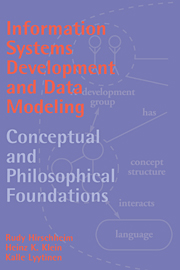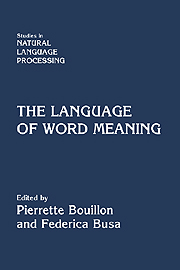Refine search
Actions for selected content:
3326 results in Artificial Intelligence and Natural Language Processing
4 - Coordination
-
- Book:
- Theory of Conditional Games
- Published online:
- 05 January 2012
- Print publication:
- 19 December 2011, pp 96-125
-
- Chapter
- Export citation
NLE volume 18 issue 1 Cover and Front matter
-
- Journal:
- Natural Language Engineering / Volume 18 / Issue 1 / January 2012
- Published online by Cambridge University Press:
- 16 December 2011, pp. f1-f2
-
- Article
-
- You have access
- Export citation
Editorial Note
-
- Journal:
- Natural Language Engineering / Volume 18 / Issue 1 / January 2012
- Published online by Cambridge University Press:
- 16 December 2011, p. i
-
- Article
-
- You have access
- HTML
- Export citation
NLE volume 18 issue 1 Cover and Back matter
-
- Journal:
- Natural Language Engineering / Volume 18 / Issue 1 / January 2012
- Published online by Cambridge University Press:
- 16 December 2011, pp. b1-b6
-
- Article
-
- You have access
- Export citation
Discourse structure and language technology
-
- Journal:
- Natural Language Engineering / Volume 18 / Issue 4 / October 2012
- Published online by Cambridge University Press:
- 08 December 2011, pp. 437-490
-
- Article
- Export citation
Part of speech tagging for Arabic
-
- Journal:
- Natural Language Engineering / Volume 18 / Issue 4 / October 2012
- Published online by Cambridge University Press:
- 06 December 2011, pp. 521-548
-
- Article
- Export citation
Automated unsupervised authorship analysis using evidence accumulation clustering
-
- Journal:
- Natural Language Engineering / Volume 19 / Issue 1 / January 2013
- Published online by Cambridge University Press:
- 21 November 2011, pp. 95-120
-
- Article
- Export citation

Information Systems Development and Data Modeling
- Conceptual and Philosophical Foundations
-
- Published online:
- 05 November 2011
- Print publication:
- 27 October 1995
Syntax-Based Collocation Extraction, by Violeta Seretan. Berlin: Springer, 2011. ISBN-10 9400701330, ISBN-13 978-9400701335. $139.00/£90.00 (Hardcover) xi + 220 pages.
-
- Journal:
- Natural Language Engineering / Volume 18 / Issue 4 / October 2012
- Published online by Cambridge University Press:
- 12 October 2011, pp. 575-579
-
- Article
- Export citation

The Language of Word Meaning
-
- Published online:
- 07 October 2011
- Print publication:
- 15 January 2001

Logical Dynamics of Information and Interaction
-
- Published online:
- 07 October 2011
- Print publication:
- 29 September 2011
7 - Soft information, correction, and belief change
-
- Book:
- Logical Dynamics of Information and Interaction
- Published online:
- 07 October 2011
- Print publication:
- 29 September 2011, pp 130-155
-
- Chapter
- Export citation
17 - Conclusion
-
- Book:
- Logical Dynamics of Information and Interaction
- Published online:
- 07 October 2011
- Print publication:
- 29 September 2011, pp 342-345
-
- Chapter
- Export citation
4 - Multi-agent dynamic-epistemic logic
-
- Book:
- Logical Dynamics of Information and Interaction
- Published online:
- 07 October 2011
- Print publication:
- 29 September 2011, pp 76-99
-
- Chapter
- Export citation
9 - Preference statics and dynamics
-
- Book:
- Logical Dynamics of Information and Interaction
- Published online:
- 07 October 2011
- Print publication:
- 29 September 2011, pp 174-194
-
- Chapter
- Export citation
16 - Meeting cognitive realities
-
- Book:
- Logical Dynamics of Information and Interaction
- Published online:
- 07 October 2011
- Print publication:
- 29 September 2011, pp 330-341
-
- Chapter
- Export citation
References
-
- Book:
- Logical Dynamics of Information and Interaction
- Published online:
- 07 October 2011
- Print publication:
- 29 September 2011, pp 346-369
-
- Chapter
- Export citation
Index
-
- Book:
- Logical Dynamics of Information and Interaction
- Published online:
- 07 October 2011
- Print publication:
- 29 September 2011, pp 370-373
-
- Chapter
- Export citation
6 - Questions and issue management
-
- Book:
- Logical Dynamics of Information and Interaction
- Published online:
- 07 October 2011
- Print publication:
- 29 September 2011, pp 114-129
-
- Chapter
- Export citation
13 - Logical dynamics in philosophy
-
- Book:
- Logical Dynamics of Information and Interaction
- Published online:
- 07 October 2011
- Print publication:
- 29 September 2011, pp 268-302
-
- Chapter
- Export citation
